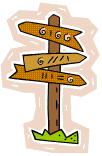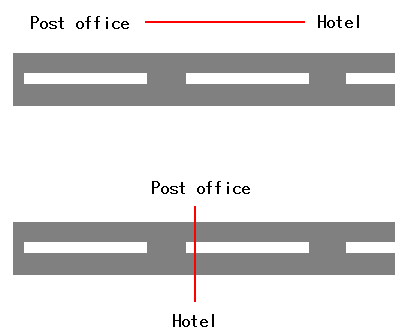EnglishCafe
 |
| Page 2 -Two cats sat on the grass at the fountain. They were talking under the trees.- "Can you tell me the way to the tennis court from here?"Roy asked. "Do you like tennis?" "I like to watch it." Ah, cats can't play it. "For a tennis court, go straight until you come to the end. And then at the corner turn right and walk straight for three blocks. You'll see it on your left. You can't miss it." "Thank you." "You're welcome." He is easygoing and lives in the house near to the campus. Because he has no sense of direction, I can't help worrying about him.  Today's points  -The point 1- Can you tell me the way to the tennis court from here? This is how to ask the way. We use "Can you tell me" with the way which we want to know. For example, "the way to the tennis court" like the above. We put the place after "to" of " the way to." So this form is "Can you tell me the way to + the place?" Excuse me. Can you tell me the way to the post office? Certainly.
Moreover, we use the following expression other than the above. The place we want to know is put in ( ). Can you tell me where ( a tennis court ) is? Can you tell me how to get to ( a tennis court )?
-The point 2- For a tennis court, go straight until you come to the end. And then at the corner turn right and walk straight for three blocks. You'll see it on your left. You can't miss it. This is the explanation to tell the way. The meanings divided one by one are as follows. Go straight ( go directly) until you come to the end. (until the end of the street) And then at the corner turn right (move right at the corner) and walk straight for three blocks. (walk directly as you count the block three times) You'll see it on your left. (you find it left)
Moreover, we also use "on your right" other than "on your left" of "You'll see it on your left." And "next to" (beside), "across from" ( opposite) are also used. The post office is next to the hotel. The post office is across from the hotel. See the figure 2-1. Figure 2-1. 
Moreover, "until you come to the end" means "Continues something and stop it when you get to the end." This "until" is conjunction. "The subject + The verb" is put after "until." The score is 3 to 5. Continue to attack until the game is finished.
About "until", it means continuous. So "until the game is finished" in the above means "Continues something and stop it when the referee whistles." Thus, we have to use the verbs which mean continuous in the other sentence (the main clause). For example, "continue" in the above, or "walk" and "go" are used. In contradiction to that, if we use the verbs which mean not continuous, we use "by" instead of "until." This means a period merely. See the following example with "send." We'll send the book by five today. (The book is sent at the time from now to five.)
Moreover, "work" with "until" and "by" is as follows. I have to work until eight. (Continue working and stop it at eight.) I have to finish the work by eight. (Finish the job from now to eight.)
-The point 3- You're welcome. This is used for the answer to "Thank you." This means "Don't mention it.", "Not at all" and "No problem." Thanks for your time. You're welcome. -The point 4- Because he has no sense of direction, I can't help worrying about him. "I can't help worrying about him." means "I have to worry about him long time." This "help" means "give a hand", but also has avoidance. Thus "can't help" means "can't avoid" and the ing verb form is used after "help." This form is "I can't help + the ing verb form." This means "have to do necessarily." We couldn't help laughing because she made a joke about the teacher yesterday. (We can't stop laughing.) Oh, I wanted to listen. I forgot the term assignments. It can't be helped. I'll check them tomorrow. (I can't do it.) What were you doing last night? I was waiting for you. I'm sorry. I couldn't help it. I had to work late. Give me a phone call.
|
| previous page | EnglishCafe Top | following page |
| Copyright (c) EnglishCafe : Unapproved printing of the text and figure in this site is forbidden. |
